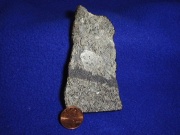Difference between revisions of "Platinum"
m (Text replace - "== Authority ==" to "== Sources Checked for Data in Record ==") |
|||
| Line 48: | Line 48: | ||
° Web Elements: [http://www.webelements.com/webelements/elements/text/Pt/key.html Website]° Mineralogy Database: [http://www.webmineral.com/data/Platinum.shtml Platinum] | ° Web Elements: [http://www.webelements.com/webelements/elements/text/Pt/key.html Website]° Mineralogy Database: [http://www.webmineral.com/data/Platinum.shtml Platinum] | ||
| − | == | + | == Sources Checked for Data in Record == |
* Richard S. Lewis, ''Hawley's Condensed Chemical Dictionary'', Van Nostrand Reinhold, New York, 10th ed., 1993 | * Richard S. Lewis, ''Hawley's Condensed Chemical Dictionary'', Van Nostrand Reinhold, New York, 10th ed., 1993 | ||
Revision as of 14:58, 1 May 2016
Description
A silvery white, metallic element. Platinum is found as fine grains of native ore in alluvial Gold deposits and in Nickel ores. It is often mixed with other platinum group metals such as iridium, osmium, and palladium. The abundance of platinum in the earth's crust is 0.01 ppm. Platinum was used by pre-Columbian Indians and has been found in other ancient pieces, such as a metal inlay in Egyptian boxes. In the 16th century, significant alluvial deposits were discovered by Jesuits in the Rio Pinto in Columbia; these were later described as a new metal in reports by Antonio de Ulloa in 1735 (see authority entries). Platinum was recognized as a precious metal following purification by the French physicist P.F. Chabaneau in 1789. It was rarely used, however, until deposits were found in the Ural Mountains in 1822. Currently platinum is mined in South Africa (Transvaal), Russia, Finland, Ireland, Borneo, New South Wales, New Zealand, Brazil, Peru, Madagascar, Canada (British Columbia, and in Alberta) and the U.S. (Alaska, California, Oregon). Platinum is ductile, malleable and can be formed into a thin, silvery-color leaf. Because it does not oxidize in air or tarnish in the presence of Sulfur compounds, platinum was used for decoration on sculpture and pottery to simulate Silver. It is also used for jewelry, pen points, electrical contacts, thermocouple wires, surgical tools, dentistry, electroplating, and as a catalyst.
Synonyms and Related Terms
Pt; platina; alutiae (Pliny); platina del Pinto (Columbia); platina (Ned., Sven.); platine (Fr.); Platin (Deut.); platino (It., Esp.); platínio (Port.)
Other Properties
Slightly soluble in aqua regia; resistant to other acids. Reacts with caustic alkalis, alkali cyanides and alkali nitrates.
Isometric crystal system-usually found as distorted cubes. Malleable and ductile. Luster = metallic. Streak = light gray. Does not tarnish. Slightly magnetic.
| Composition | Pt (atomic no. 78) |
|---|---|
| CAS | 7440-06-4 |
| Melting Point | 1773.5 |
| Density | 21.447 |
| Molecular Weight | atomic wt = 195.09 |
| Boiling Point | 3827 |
Hazards and Safety
Inhalation of dust may cause irritation. Powder is flammable. Platinum salts are highly toxic.
Fisher Scientific: MSDS
Additional Information
° Web Elements: Website° Mineralogy Database: Platinum
Sources Checked for Data in Record
- Richard S. Lewis, Hawley's Condensed Chemical Dictionary, Van Nostrand Reinhold, New York, 10th ed., 1993
- Van Nostrand's Scientific Encyclopedia, Douglas M. Considine (ed.), Van Nostrand Reinhold, New York, 1976 Comment: First discovered = 16th century
- The Merck Index, Martha Windholz (ed.), Merck Research Labs, Rahway NJ, 10th edition, 1983 Comment: entry 7689; First discovered = 1735
- The American Heritage Dictionary or Encarta, via Microsoft Bookshelf 98, Microsoft Corp., 1998 Comment: First discovered = 16th century
- Chemical & Engineering News, American Chemical Society, Washington DC, 81 (36) , Sept. 8, 2003 Comment: Richard Gross, p. 149: noticed by Western scientists in 1735. Credit for its modern rediscovery is usually given to Antonio de Ulloa.
- Encyclopedia Britannica, http://www.britannica.com Comment: "platinum" Encyclopædia Britannica [Accessed December 11, 2001]. deposits found by "Jesuits in the 16th century...pure metal was first produced by the French physicist P.F. Chabaneau in 1789"
- C.W.Chesterman, K.E.Lowe, Audubon Society Field Guide to North American Rocks and Minerals, Alfred A. Knopf, New York, 1979
- David C. Scott, Metallography and Microstructure of Ancient and Historic Metals, The Getty Conservation Institute, Los Angeles, 1991 Comment: "First discovered in South America by Ulloa in 1735 but used by the Indians of Ecuador and Colombia who sintered the metal with gold"
- R.D. Harley, Artists' Pigments c. 1600-1835, Butterworth Scientific, London, 1982 Comment: "In the 18th c. platinum was obtained from alluvial deposits in one of the Spanish American colonies now Colombia and an account of the metal was published in 1750."
- Jack Odgen, Jewellery of the Ancient World, Rizzoli International Publications Inc., New York City, 1982
- A History of Technology, Charles Singer, E.J. Holmyard, A.R. Hall (eds.), Clarendon Press, Oxford, Volume 1: From Early times to Fall of Ancient Empires, 1954 Comment: "Platinum was discovered in the sixteenth c. about 1538 in Colombia SA where it received the name platina del Pinto"
- Website address 1 Comment: Web Elements at http://www.webelements.com/webelements/elements/text/Pt/hist.html states first discovered by Antonio de Ulloa in South America in 1735.


